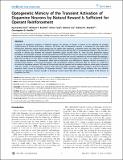| dc.contributor.author | Kim, Kyung Man | |
| dc.contributor.author | Baratta, Michael V. | |
| dc.contributor.author | Yang, Aimei | |
| dc.contributor.author | Lee, Doheon | |
| dc.contributor.author | Fiorillo, Christopher D. | |
| dc.contributor.author | Boyden, Edward | |
| dc.date.accessioned | 2012-08-29T16:03:04Z | |
| dc.date.available | 2012-08-29T16:03:04Z | |
| dc.date.issued | 2012-04 | |
| dc.date.submitted | 2011-10 | |
| dc.identifier.issn | 1932-6203 | |
| dc.identifier.uri | http://hdl.handle.net/1721.1/72422 | |
| dc.description.abstract | Activation of dopamine receptors in forebrain regions, for minutes or longer, is known to be sufficient for positive reinforcement of stimuli and actions. However, the firing rate of dopamine neurons is increased for only about 200 milliseconds following natural reward events that are better than expected, a response which has been described as a “reward prediction error” (RPE). Although RPE drives reinforcement learning (RL) in computational models, it has not been possible to directly test whether the transient dopamine signal actually drives RL. Here we have performed optical stimulation of genetically targeted ventral tegmental area (VTA) dopamine neurons expressing Channelrhodopsin-2 (ChR2) in mice. We mimicked the transient activation of dopamine neurons that occurs in response to natural reward by applying a light pulse of 200 ms in VTA. When a single light pulse followed each self-initiated nose poke, it was sufficient in itself to cause operant reinforcement. Furthermore, when optical stimulation was delivered in separate sessions according to a predetermined pattern, it increased locomotion and contralateral rotations, behaviors that are known to result from activation of dopamine neurons. All three of the optically induced operant and locomotor behaviors were tightly correlated with the number of VTA dopamine neurons that expressed ChR2, providing additional evidence that the behavioral responses were caused by activation of dopamine neurons. These results provide strong evidence that the transient activation of dopamine neurons provides a functional reward signal that drives learning, in support of RL theories of dopamine function. | en_US |
| dc.language.iso | en_US | |
| dc.publisher | Public Library of Science | en_US |
| dc.relation.isversionof | http://dx.doi.org/10.1371/journal.pone.0033612 | en_US |
| dc.rights | Creative Commons Attribution | en_US |
| dc.rights.uri | http://creativecommons.org/licenses/by/2.5/ | en_US |
| dc.source | PLoS | en_US |
| dc.title | Optogenetic Mimicry of the Transient Activation of Dopamine Neurons by Natural Reward Is Sufficient for Operant Reinforcement | en_US |
| dc.type | Article | en_US |
| dc.identifier.citation | Kim, Kyung Man et al. “Optogenetic Mimicry of the Transient Activation of Dopamine Neurons by Natural Reward Is Sufficient for Operant Reinforcement.” Ed. Xiaoxi Zhuang. PLoS ONE 7.4 (2012): e33612. | en_US |
| dc.contributor.department | Massachusetts Institute of Technology. Department of Biological Engineering | en_US |
| dc.contributor.department | Massachusetts Institute of Technology. Media Laboratory | en_US |
| dc.contributor.department | McGovern Institute for Brain Research at MIT | en_US |
| dc.contributor.department | Program in Media Arts and Sciences (Massachusetts Institute of Technology) | en_US |
| dc.contributor.approver | Yang, Aimei | |
| dc.contributor.mitauthor | Baratta, Michael V. | |
| dc.contributor.mitauthor | Yang, Aimei | |
| dc.contributor.mitauthor | Boyden, Edward Stuart | |
| dc.relation.journal | PLoS ONE | en_US |
| dc.eprint.version | Final published version | en_US |
| dc.type.uri | http://purl.org/eprint/type/JournalArticle | en_US |
| eprint.status | http://purl.org/eprint/status/PeerReviewed | en_US |
| dspace.orderedauthors | Kim, Kyung Man; Baratta, Michael V.; Yang, Aimei; Lee, Doheon; Boyden, Edward S.; Fiorillo, Christopher D. | en |
| dc.identifier.orcid | https://orcid.org/0000-0002-0419-3351 | |
| mit.license | PUBLISHER_CC | en_US |
| mit.metadata.status | Complete | |
